Economics Assignment: Monopoly, Competition, and Australian Industries
VerifiedAdded on 2023/06/07
|15
|3211
|187
Essay
AI Summary
This economics assignment delves into the concepts of market structures, specifically focusing on monopoly and monopolistic competition, with a particular emphasis on the Australian context. The essay begins by defining market structures and then analyzes the characteristics of monopoly and monopolistically competitive markets, illustrating these with case studies of Australia Post (monopoly) and the restaurant industry (monopolistic competition). It further examines the role of government in regulating monopolies, including strategies like taxation, subsidies, and price controls, while explaining why similar interventions are generally not applied to monopolistically competitive businesses. The assignment highlights the impact of market power, price discrimination, and the concept of deadweight loss within a monopoly market. Overall, the essay provides a comprehensive overview of market dynamics and the role of government policies in shaping economic landscapes.
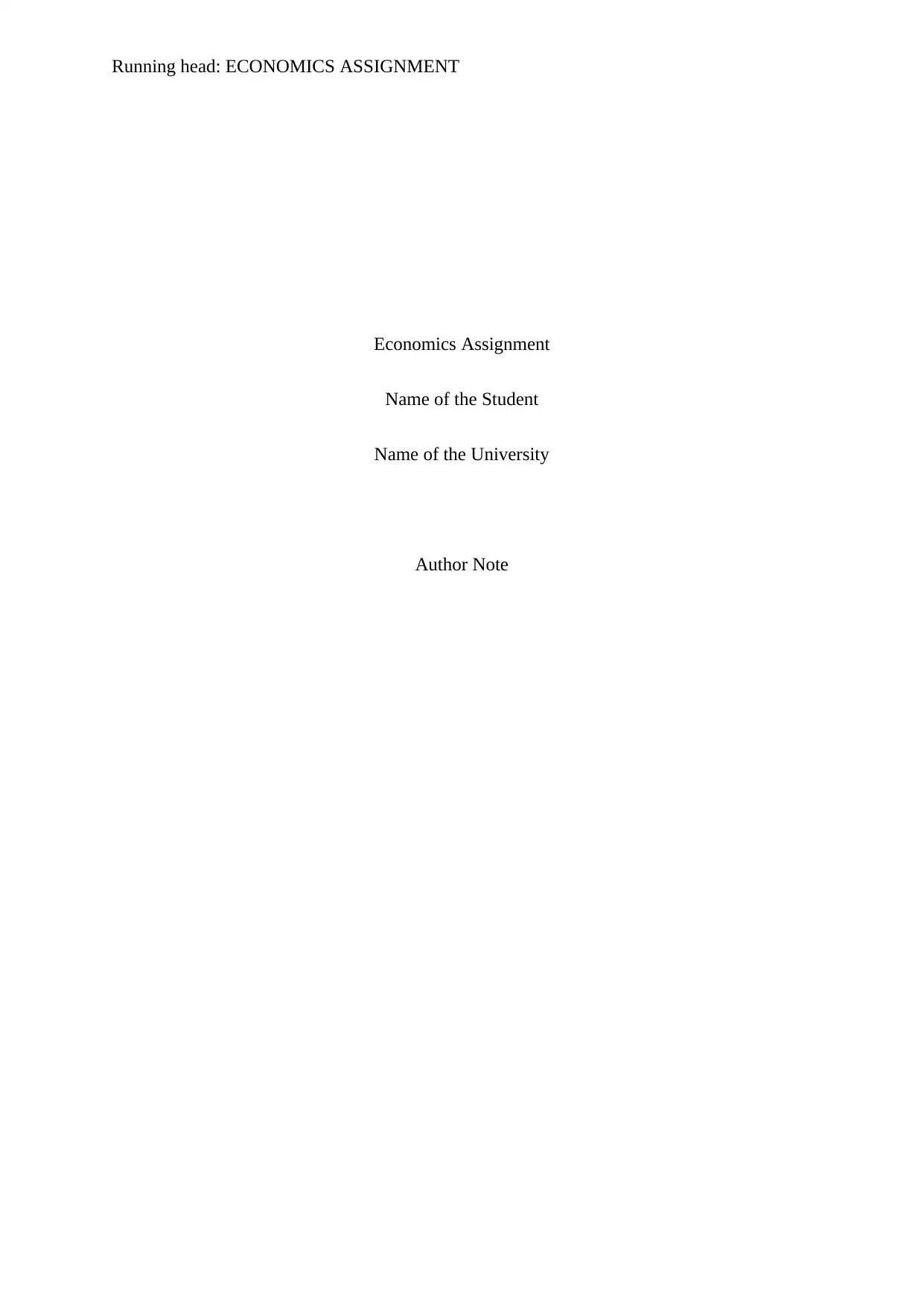
Running head: ECONOMICS ASSIGNMENT
Economics Assignment
Name of the Student
Name of the University
Author Note
Economics Assignment
Name of the Student
Name of the University
Author Note
Paraphrase This Document
Need a fresh take? Get an instant paraphrase of this document with our AI Paraphraser
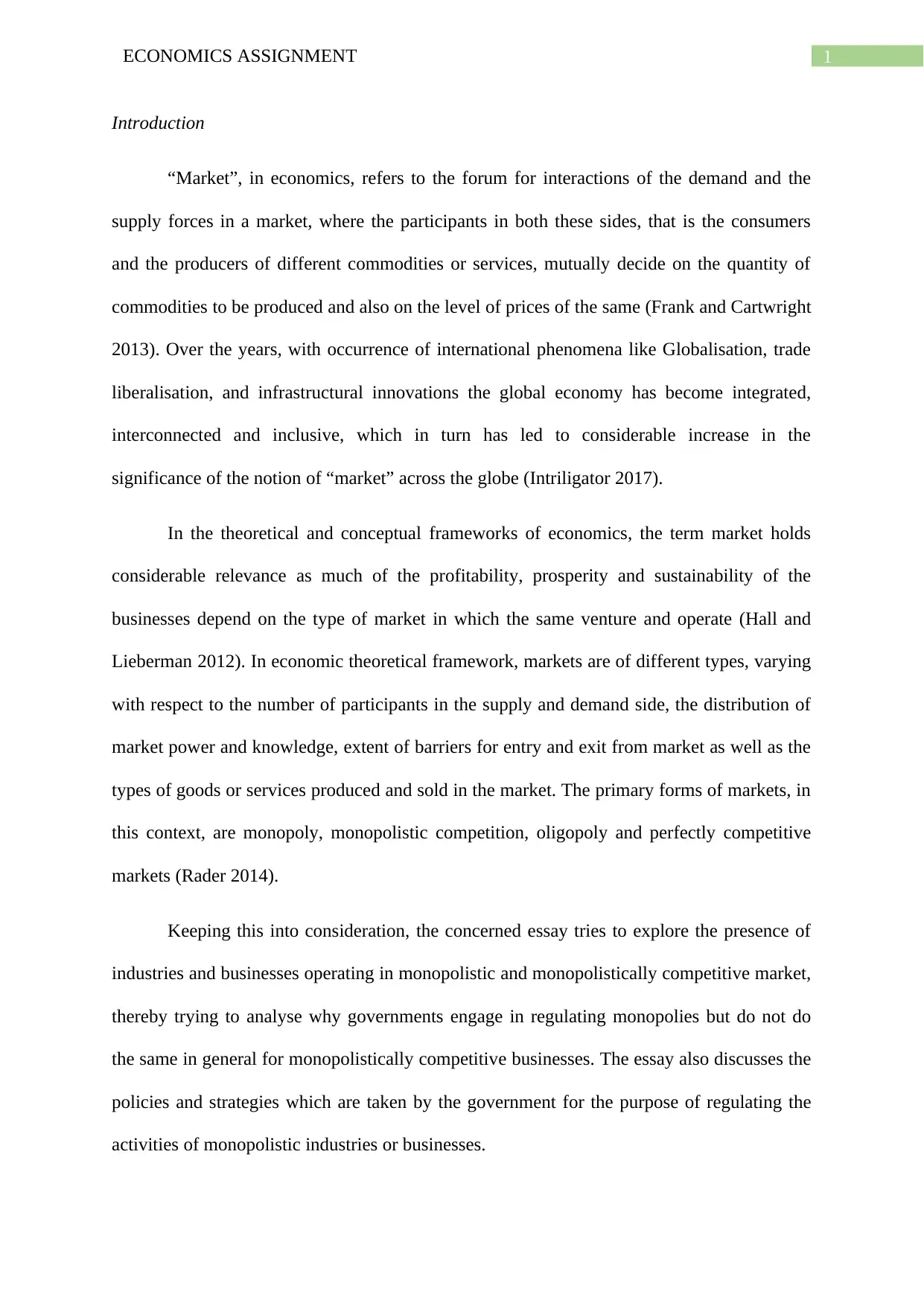
1ECONOMICS ASSIGNMENT
Introduction
“Market”, in economics, refers to the forum for interactions of the demand and the
supply forces in a market, where the participants in both these sides, that is the consumers
and the producers of different commodities or services, mutually decide on the quantity of
commodities to be produced and also on the level of prices of the same (Frank and Cartwright
2013). Over the years, with occurrence of international phenomena like Globalisation, trade
liberalisation, and infrastructural innovations the global economy has become integrated,
interconnected and inclusive, which in turn has led to considerable increase in the
significance of the notion of “market” across the globe (Intriligator 2017).
In the theoretical and conceptual frameworks of economics, the term market holds
considerable relevance as much of the profitability, prosperity and sustainability of the
businesses depend on the type of market in which the same venture and operate (Hall and
Lieberman 2012). In economic theoretical framework, markets are of different types, varying
with respect to the number of participants in the supply and demand side, the distribution of
market power and knowledge, extent of barriers for entry and exit from market as well as the
types of goods or services produced and sold in the market. The primary forms of markets, in
this context, are monopoly, monopolistic competition, oligopoly and perfectly competitive
markets (Rader 2014).
Keeping this into consideration, the concerned essay tries to explore the presence of
industries and businesses operating in monopolistic and monopolistically competitive market,
thereby trying to analyse why governments engage in regulating monopolies but do not do
the same in general for monopolistically competitive businesses. The essay also discusses the
policies and strategies which are taken by the government for the purpose of regulating the
activities of monopolistic industries or businesses.
Introduction
“Market”, in economics, refers to the forum for interactions of the demand and the
supply forces in a market, where the participants in both these sides, that is the consumers
and the producers of different commodities or services, mutually decide on the quantity of
commodities to be produced and also on the level of prices of the same (Frank and Cartwright
2013). Over the years, with occurrence of international phenomena like Globalisation, trade
liberalisation, and infrastructural innovations the global economy has become integrated,
interconnected and inclusive, which in turn has led to considerable increase in the
significance of the notion of “market” across the globe (Intriligator 2017).
In the theoretical and conceptual frameworks of economics, the term market holds
considerable relevance as much of the profitability, prosperity and sustainability of the
businesses depend on the type of market in which the same venture and operate (Hall and
Lieberman 2012). In economic theoretical framework, markets are of different types, varying
with respect to the number of participants in the supply and demand side, the distribution of
market power and knowledge, extent of barriers for entry and exit from market as well as the
types of goods or services produced and sold in the market. The primary forms of markets, in
this context, are monopoly, monopolistic competition, oligopoly and perfectly competitive
markets (Rader 2014).
Keeping this into consideration, the concerned essay tries to explore the presence of
industries and businesses operating in monopolistic and monopolistically competitive market,
thereby trying to analyse why governments engage in regulating monopolies but do not do
the same in general for monopolistically competitive businesses. The essay also discusses the
policies and strategies which are taken by the government for the purpose of regulating the
activities of monopolistic industries or businesses.
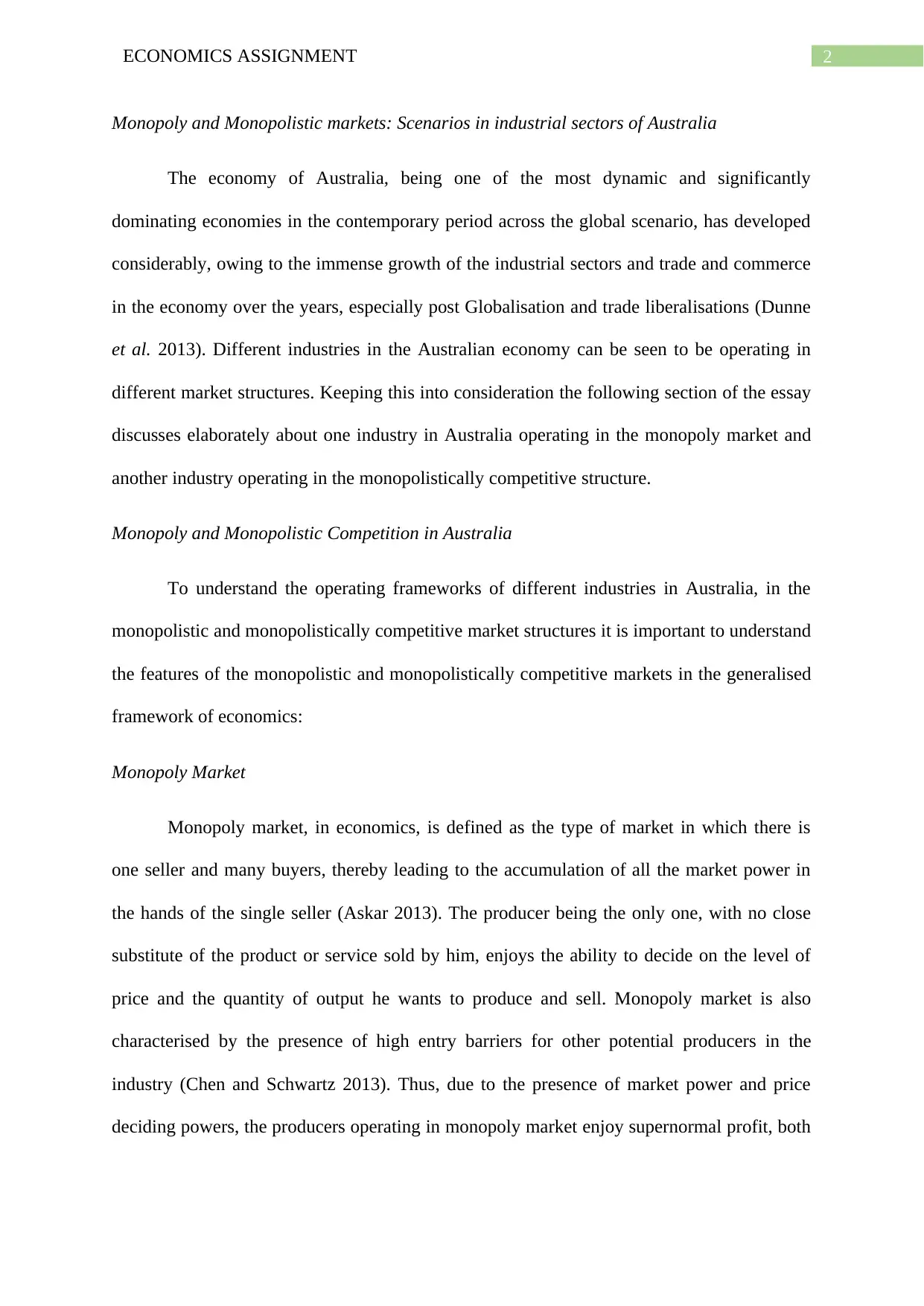
2ECONOMICS ASSIGNMENT
Monopoly and Monopolistic markets: Scenarios in industrial sectors of Australia
The economy of Australia, being one of the most dynamic and significantly
dominating economies in the contemporary period across the global scenario, has developed
considerably, owing to the immense growth of the industrial sectors and trade and commerce
in the economy over the years, especially post Globalisation and trade liberalisations (Dunne
et al. 2013). Different industries in the Australian economy can be seen to be operating in
different market structures. Keeping this into consideration the following section of the essay
discusses elaborately about one industry in Australia operating in the monopoly market and
another industry operating in the monopolistically competitive structure.
Monopoly and Monopolistic Competition in Australia
To understand the operating frameworks of different industries in Australia, in the
monopolistic and monopolistically competitive market structures it is important to understand
the features of the monopolistic and monopolistically competitive markets in the generalised
framework of economics:
Monopoly Market
Monopoly market, in economics, is defined as the type of market in which there is
one seller and many buyers, thereby leading to the accumulation of all the market power in
the hands of the single seller (Askar 2013). The producer being the only one, with no close
substitute of the product or service sold by him, enjoys the ability to decide on the level of
price and the quantity of output he wants to produce and sell. Monopoly market is also
characterised by the presence of high entry barriers for other potential producers in the
industry (Chen and Schwartz 2013). Thus, due to the presence of market power and price
deciding powers, the producers operating in monopoly market enjoy supernormal profit, both
Monopoly and Monopolistic markets: Scenarios in industrial sectors of Australia
The economy of Australia, being one of the most dynamic and significantly
dominating economies in the contemporary period across the global scenario, has developed
considerably, owing to the immense growth of the industrial sectors and trade and commerce
in the economy over the years, especially post Globalisation and trade liberalisations (Dunne
et al. 2013). Different industries in the Australian economy can be seen to be operating in
different market structures. Keeping this into consideration the following section of the essay
discusses elaborately about one industry in Australia operating in the monopoly market and
another industry operating in the monopolistically competitive structure.
Monopoly and Monopolistic Competition in Australia
To understand the operating frameworks of different industries in Australia, in the
monopolistic and monopolistically competitive market structures it is important to understand
the features of the monopolistic and monopolistically competitive markets in the generalised
framework of economics:
Monopoly Market
Monopoly market, in economics, is defined as the type of market in which there is
one seller and many buyers, thereby leading to the accumulation of all the market power in
the hands of the single seller (Askar 2013). The producer being the only one, with no close
substitute of the product or service sold by him, enjoys the ability to decide on the level of
price and the quantity of output he wants to produce and sell. Monopoly market is also
characterised by the presence of high entry barriers for other potential producers in the
industry (Chen and Schwartz 2013). Thus, due to the presence of market power and price
deciding powers, the producers operating in monopoly market enjoy supernormal profit, both
⊘ This is a preview!⊘
Do you want full access?
Subscribe today to unlock all pages.

Trusted by 1+ million students worldwide
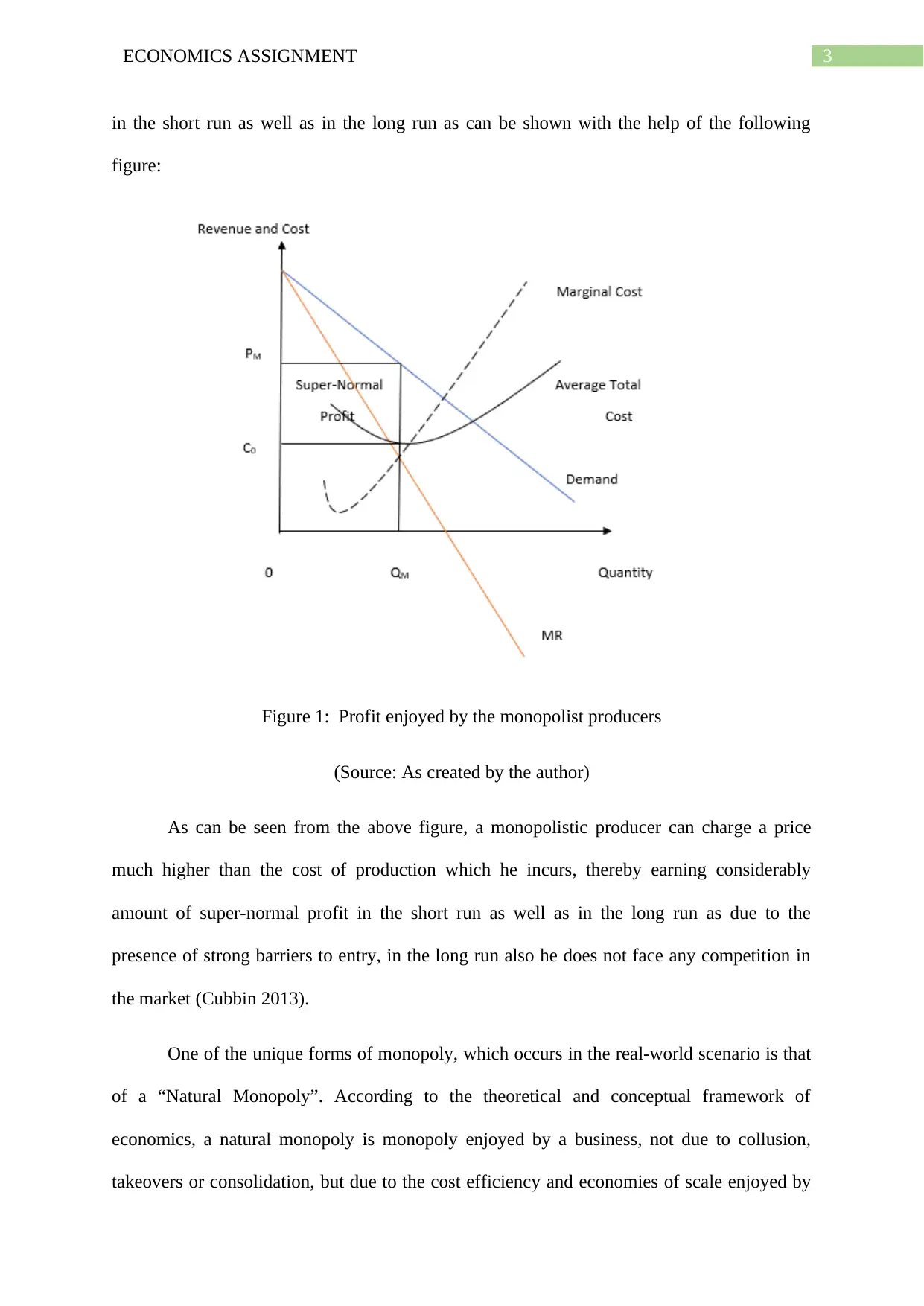
3ECONOMICS ASSIGNMENT
in the short run as well as in the long run as can be shown with the help of the following
figure:
Figure 1: Profit enjoyed by the monopolist producers
(Source: As created by the author)
As can be seen from the above figure, a monopolistic producer can charge a price
much higher than the cost of production which he incurs, thereby earning considerably
amount of super-normal profit in the short run as well as in the long run as due to the
presence of strong barriers to entry, in the long run also he does not face any competition in
the market (Cubbin 2013).
One of the unique forms of monopoly, which occurs in the real-world scenario is that
of a “Natural Monopoly”. According to the theoretical and conceptual framework of
economics, a natural monopoly is monopoly enjoyed by a business, not due to collusion,
takeovers or consolidation, but due to the cost efficiency and economies of scale enjoyed by
in the short run as well as in the long run as can be shown with the help of the following
figure:
Figure 1: Profit enjoyed by the monopolist producers
(Source: As created by the author)
As can be seen from the above figure, a monopolistic producer can charge a price
much higher than the cost of production which he incurs, thereby earning considerably
amount of super-normal profit in the short run as well as in the long run as due to the
presence of strong barriers to entry, in the long run also he does not face any competition in
the market (Cubbin 2013).
One of the unique forms of monopoly, which occurs in the real-world scenario is that
of a “Natural Monopoly”. According to the theoretical and conceptual framework of
economics, a natural monopoly is monopoly enjoyed by a business, not due to collusion,
takeovers or consolidation, but due to the cost efficiency and economies of scale enjoyed by
Paraphrase This Document
Need a fresh take? Get an instant paraphrase of this document with our AI Paraphraser
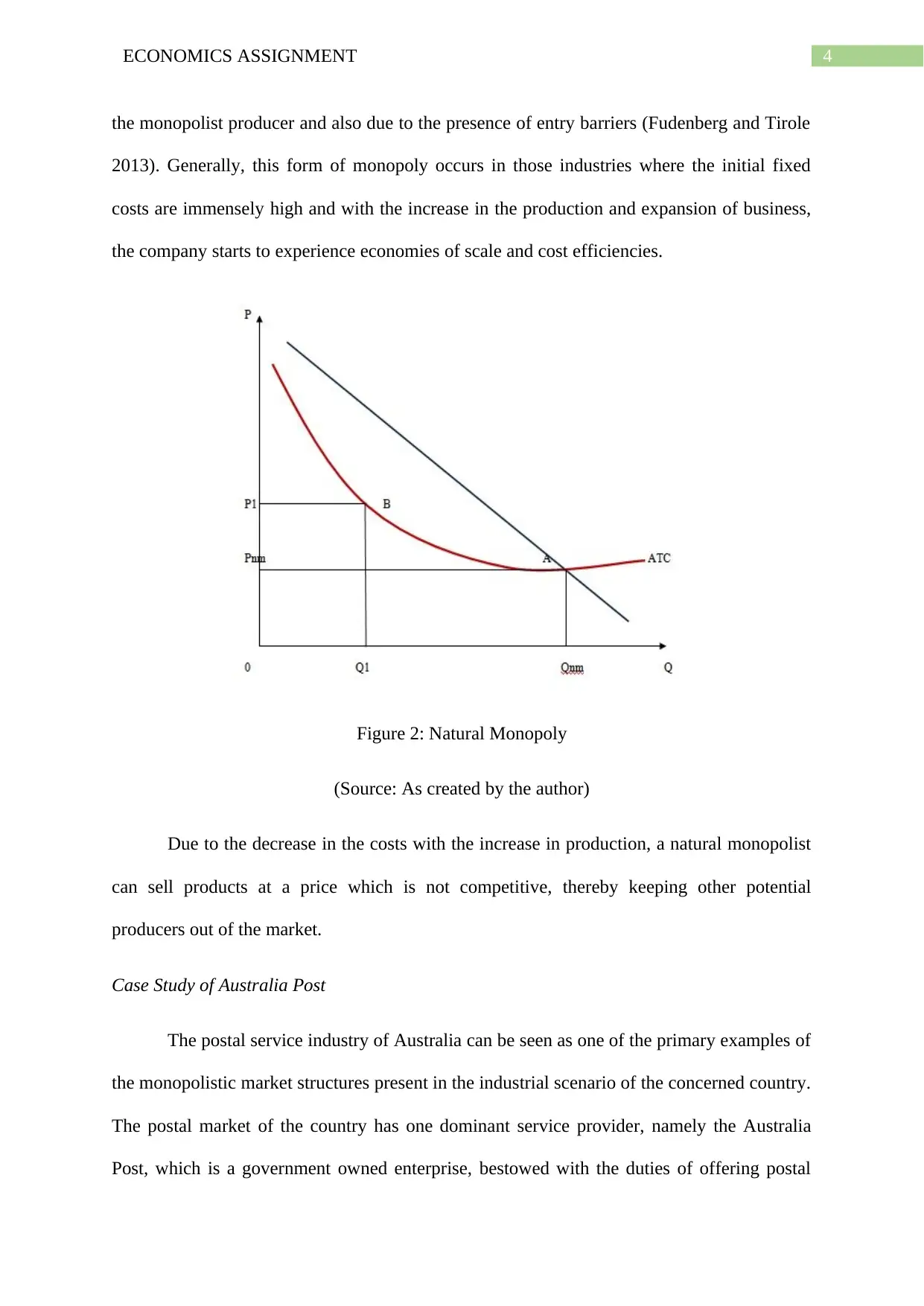
4ECONOMICS ASSIGNMENT
the monopolist producer and also due to the presence of entry barriers (Fudenberg and Tirole
2013). Generally, this form of monopoly occurs in those industries where the initial fixed
costs are immensely high and with the increase in the production and expansion of business,
the company starts to experience economies of scale and cost efficiencies.
Figure 2: Natural Monopoly
(Source: As created by the author)
Due to the decrease in the costs with the increase in production, a natural monopolist
can sell products at a price which is not competitive, thereby keeping other potential
producers out of the market.
Case Study of Australia Post
The postal service industry of Australia can be seen as one of the primary examples of
the monopolistic market structures present in the industrial scenario of the concerned country.
The postal market of the country has one dominant service provider, namely the Australia
Post, which is a government owned enterprise, bestowed with the duties of offering postal
the monopolist producer and also due to the presence of entry barriers (Fudenberg and Tirole
2013). Generally, this form of monopoly occurs in those industries where the initial fixed
costs are immensely high and with the increase in the production and expansion of business,
the company starts to experience economies of scale and cost efficiencies.
Figure 2: Natural Monopoly
(Source: As created by the author)
Due to the decrease in the costs with the increase in production, a natural monopolist
can sell products at a price which is not competitive, thereby keeping other potential
producers out of the market.
Case Study of Australia Post
The postal service industry of Australia can be seen as one of the primary examples of
the monopolistic market structures present in the industrial scenario of the concerned country.
The postal market of the country has one dominant service provider, namely the Australia
Post, which is a government owned enterprise, bestowed with the duties of offering postal
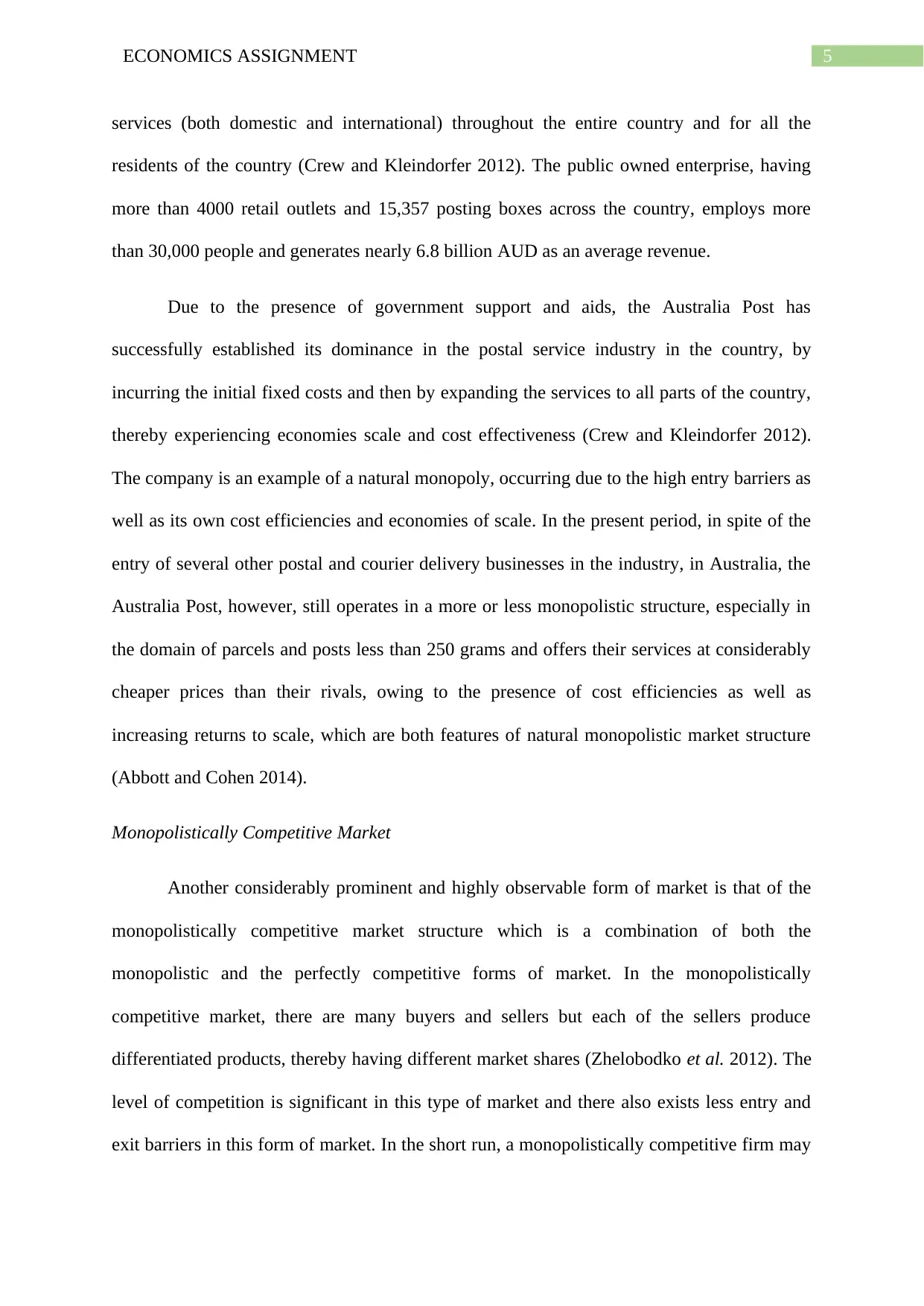
5ECONOMICS ASSIGNMENT
services (both domestic and international) throughout the entire country and for all the
residents of the country (Crew and Kleindorfer 2012). The public owned enterprise, having
more than 4000 retail outlets and 15,357 posting boxes across the country, employs more
than 30,000 people and generates nearly 6.8 billion AUD as an average revenue.
Due to the presence of government support and aids, the Australia Post has
successfully established its dominance in the postal service industry in the country, by
incurring the initial fixed costs and then by expanding the services to all parts of the country,
thereby experiencing economies scale and cost effectiveness (Crew and Kleindorfer 2012).
The company is an example of a natural monopoly, occurring due to the high entry barriers as
well as its own cost efficiencies and economies of scale. In the present period, in spite of the
entry of several other postal and courier delivery businesses in the industry, in Australia, the
Australia Post, however, still operates in a more or less monopolistic structure, especially in
the domain of parcels and posts less than 250 grams and offers their services at considerably
cheaper prices than their rivals, owing to the presence of cost efficiencies as well as
increasing returns to scale, which are both features of natural monopolistic market structure
(Abbott and Cohen 2014).
Monopolistically Competitive Market
Another considerably prominent and highly observable form of market is that of the
monopolistically competitive market structure which is a combination of both the
monopolistic and the perfectly competitive forms of market. In the monopolistically
competitive market, there are many buyers and sellers but each of the sellers produce
differentiated products, thereby having different market shares (Zhelobodko et al. 2012). The
level of competition is significant in this type of market and there also exists less entry and
exit barriers in this form of market. In the short run, a monopolistically competitive firm may
services (both domestic and international) throughout the entire country and for all the
residents of the country (Crew and Kleindorfer 2012). The public owned enterprise, having
more than 4000 retail outlets and 15,357 posting boxes across the country, employs more
than 30,000 people and generates nearly 6.8 billion AUD as an average revenue.
Due to the presence of government support and aids, the Australia Post has
successfully established its dominance in the postal service industry in the country, by
incurring the initial fixed costs and then by expanding the services to all parts of the country,
thereby experiencing economies scale and cost effectiveness (Crew and Kleindorfer 2012).
The company is an example of a natural monopoly, occurring due to the high entry barriers as
well as its own cost efficiencies and economies of scale. In the present period, in spite of the
entry of several other postal and courier delivery businesses in the industry, in Australia, the
Australia Post, however, still operates in a more or less monopolistic structure, especially in
the domain of parcels and posts less than 250 grams and offers their services at considerably
cheaper prices than their rivals, owing to the presence of cost efficiencies as well as
increasing returns to scale, which are both features of natural monopolistic market structure
(Abbott and Cohen 2014).
Monopolistically Competitive Market
Another considerably prominent and highly observable form of market is that of the
monopolistically competitive market structure which is a combination of both the
monopolistic and the perfectly competitive forms of market. In the monopolistically
competitive market, there are many buyers and sellers but each of the sellers produce
differentiated products, thereby having different market shares (Zhelobodko et al. 2012). The
level of competition is significant in this type of market and there also exists less entry and
exit barriers in this form of market. In the short run, a monopolistically competitive firm may
⊘ This is a preview!⊘
Do you want full access?
Subscribe today to unlock all pages.

Trusted by 1+ million students worldwide
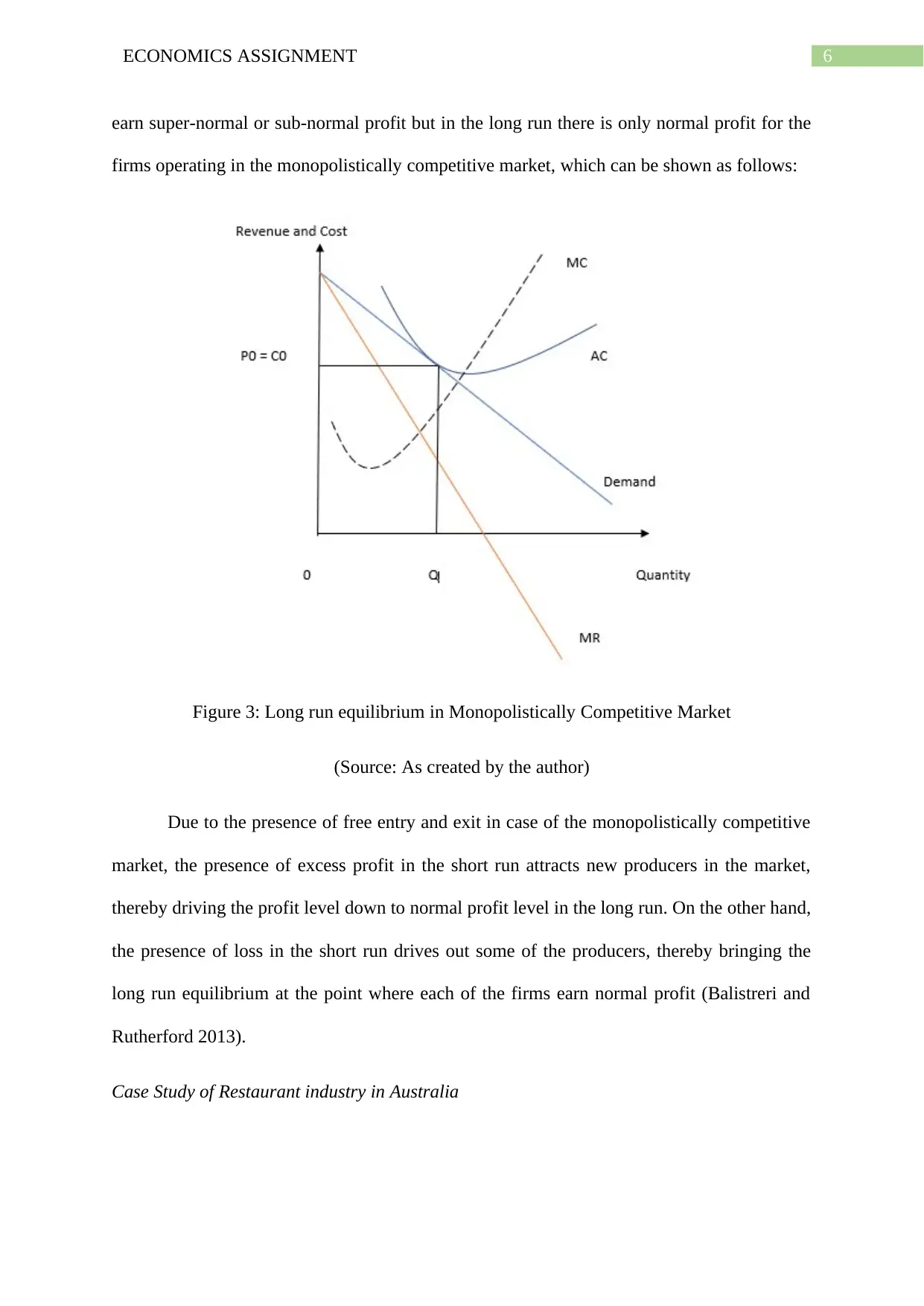
6ECONOMICS ASSIGNMENT
earn super-normal or sub-normal profit but in the long run there is only normal profit for the
firms operating in the monopolistically competitive market, which can be shown as follows:
Figure 3: Long run equilibrium in Monopolistically Competitive Market
(Source: As created by the author)
Due to the presence of free entry and exit in case of the monopolistically competitive
market, the presence of excess profit in the short run attracts new producers in the market,
thereby driving the profit level down to normal profit level in the long run. On the other hand,
the presence of loss in the short run drives out some of the producers, thereby bringing the
long run equilibrium at the point where each of the firms earn normal profit (Balistreri and
Rutherford 2013).
Case Study of Restaurant industry in Australia
earn super-normal or sub-normal profit but in the long run there is only normal profit for the
firms operating in the monopolistically competitive market, which can be shown as follows:
Figure 3: Long run equilibrium in Monopolistically Competitive Market
(Source: As created by the author)
Due to the presence of free entry and exit in case of the monopolistically competitive
market, the presence of excess profit in the short run attracts new producers in the market,
thereby driving the profit level down to normal profit level in the long run. On the other hand,
the presence of loss in the short run drives out some of the producers, thereby bringing the
long run equilibrium at the point where each of the firms earn normal profit (Balistreri and
Rutherford 2013).
Case Study of Restaurant industry in Australia
Paraphrase This Document
Need a fresh take? Get an instant paraphrase of this document with our AI Paraphraser
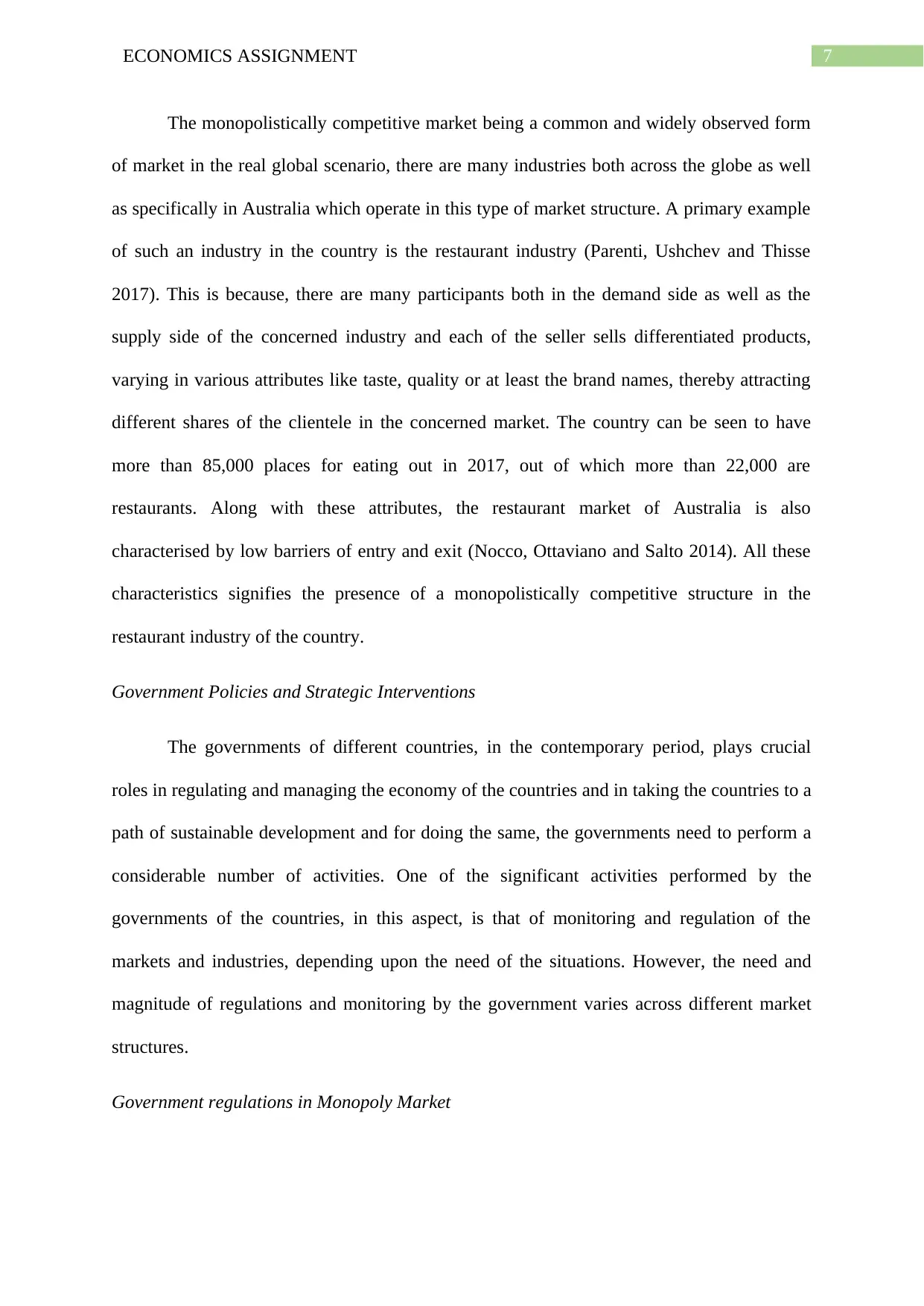
7ECONOMICS ASSIGNMENT
The monopolistically competitive market being a common and widely observed form
of market in the real global scenario, there are many industries both across the globe as well
as specifically in Australia which operate in this type of market structure. A primary example
of such an industry in the country is the restaurant industry (Parenti, Ushchev and Thisse
2017). This is because, there are many participants both in the demand side as well as the
supply side of the concerned industry and each of the seller sells differentiated products,
varying in various attributes like taste, quality or at least the brand names, thereby attracting
different shares of the clientele in the concerned market. The country can be seen to have
more than 85,000 places for eating out in 2017, out of which more than 22,000 are
restaurants. Along with these attributes, the restaurant market of Australia is also
characterised by low barriers of entry and exit (Nocco, Ottaviano and Salto 2014). All these
characteristics signifies the presence of a monopolistically competitive structure in the
restaurant industry of the country.
Government Policies and Strategic Interventions
The governments of different countries, in the contemporary period, plays crucial
roles in regulating and managing the economy of the countries and in taking the countries to a
path of sustainable development and for doing the same, the governments need to perform a
considerable number of activities. One of the significant activities performed by the
governments of the countries, in this aspect, is that of monitoring and regulation of the
markets and industries, depending upon the need of the situations. However, the need and
magnitude of regulations and monitoring by the government varies across different market
structures.
Government regulations in Monopoly Market
The monopolistically competitive market being a common and widely observed form
of market in the real global scenario, there are many industries both across the globe as well
as specifically in Australia which operate in this type of market structure. A primary example
of such an industry in the country is the restaurant industry (Parenti, Ushchev and Thisse
2017). This is because, there are many participants both in the demand side as well as the
supply side of the concerned industry and each of the seller sells differentiated products,
varying in various attributes like taste, quality or at least the brand names, thereby attracting
different shares of the clientele in the concerned market. The country can be seen to have
more than 85,000 places for eating out in 2017, out of which more than 22,000 are
restaurants. Along with these attributes, the restaurant market of Australia is also
characterised by low barriers of entry and exit (Nocco, Ottaviano and Salto 2014). All these
characteristics signifies the presence of a monopolistically competitive structure in the
restaurant industry of the country.
Government Policies and Strategic Interventions
The governments of different countries, in the contemporary period, plays crucial
roles in regulating and managing the economy of the countries and in taking the countries to a
path of sustainable development and for doing the same, the governments need to perform a
considerable number of activities. One of the significant activities performed by the
governments of the countries, in this aspect, is that of monitoring and regulation of the
markets and industries, depending upon the need of the situations. However, the need and
magnitude of regulations and monitoring by the government varies across different market
structures.
Government regulations in Monopoly Market
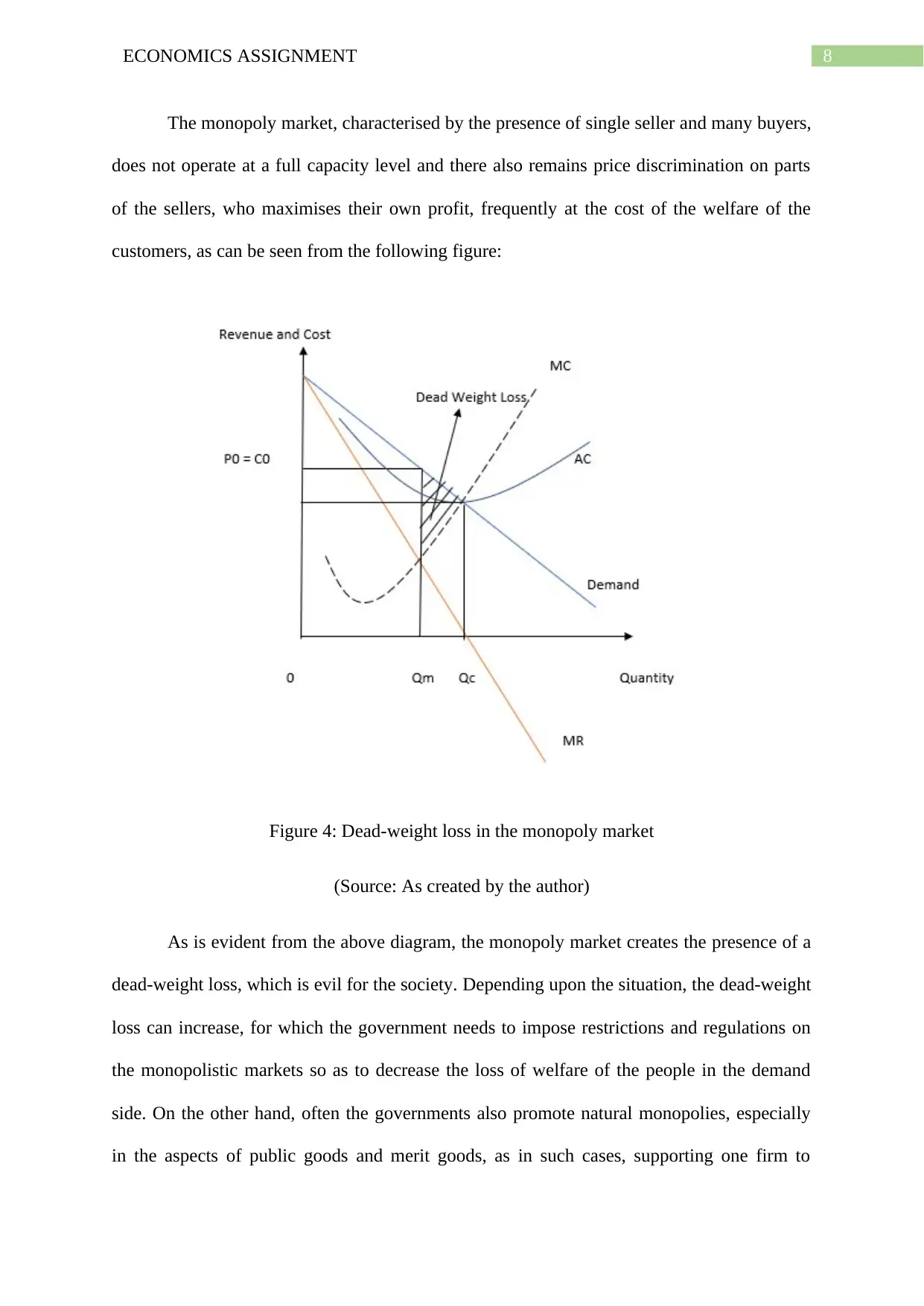
8ECONOMICS ASSIGNMENT
The monopoly market, characterised by the presence of single seller and many buyers,
does not operate at a full capacity level and there also remains price discrimination on parts
of the sellers, who maximises their own profit, frequently at the cost of the welfare of the
customers, as can be seen from the following figure:
Figure 4: Dead-weight loss in the monopoly market
(Source: As created by the author)
As is evident from the above diagram, the monopoly market creates the presence of a
dead-weight loss, which is evil for the society. Depending upon the situation, the dead-weight
loss can increase, for which the government needs to impose restrictions and regulations on
the monopolistic markets so as to decrease the loss of welfare of the people in the demand
side. On the other hand, often the governments also promote natural monopolies, especially
in the aspects of public goods and merit goods, as in such cases, supporting one firm to
The monopoly market, characterised by the presence of single seller and many buyers,
does not operate at a full capacity level and there also remains price discrimination on parts
of the sellers, who maximises their own profit, frequently at the cost of the welfare of the
customers, as can be seen from the following figure:
Figure 4: Dead-weight loss in the monopoly market
(Source: As created by the author)
As is evident from the above diagram, the monopoly market creates the presence of a
dead-weight loss, which is evil for the society. Depending upon the situation, the dead-weight
loss can increase, for which the government needs to impose restrictions and regulations on
the monopolistic markets so as to decrease the loss of welfare of the people in the demand
side. On the other hand, often the governments also promote natural monopolies, especially
in the aspects of public goods and merit goods, as in such cases, supporting one firm to
⊘ This is a preview!⊘
Do you want full access?
Subscribe today to unlock all pages.

Trusted by 1+ million students worldwide
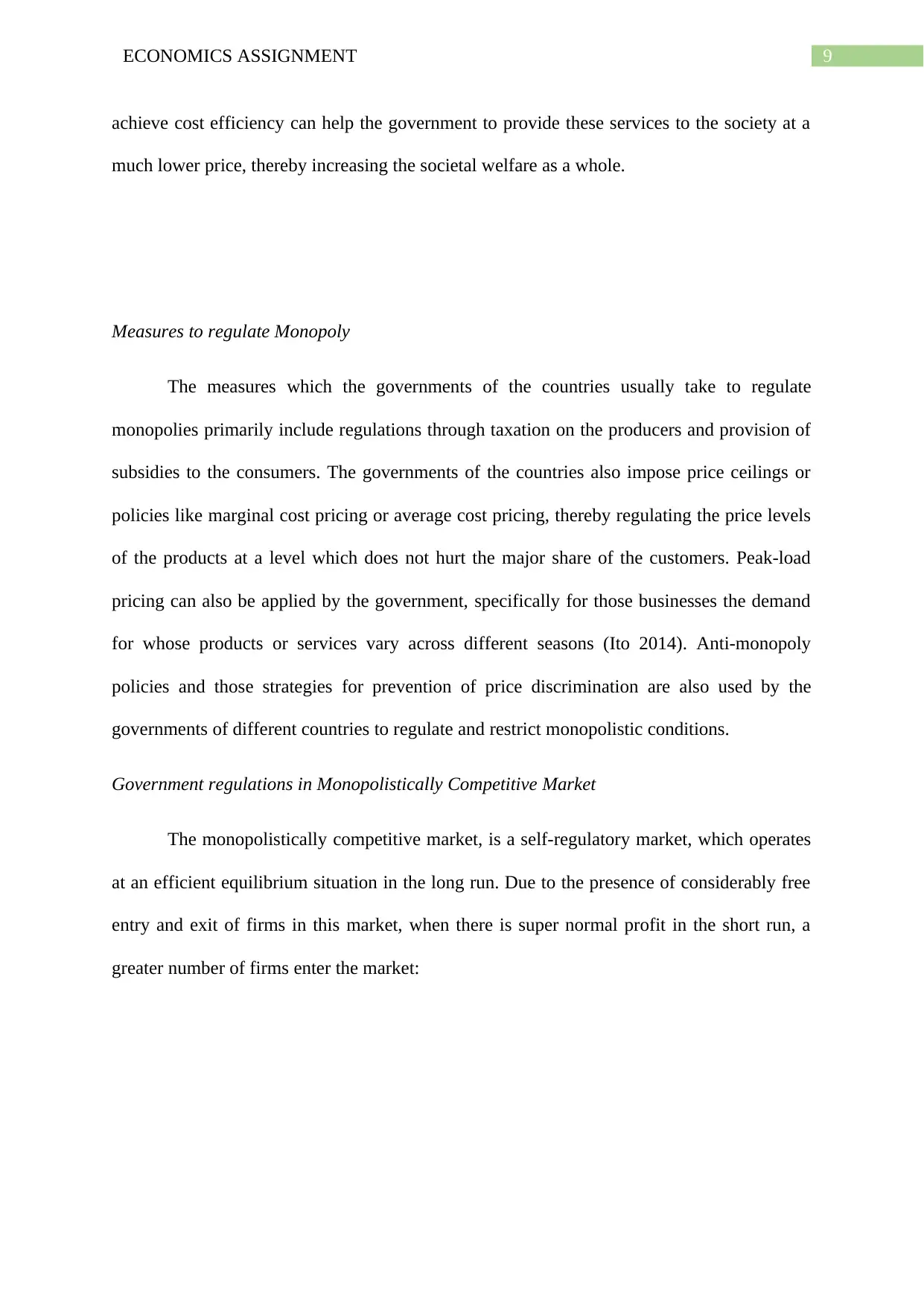
9ECONOMICS ASSIGNMENT
achieve cost efficiency can help the government to provide these services to the society at a
much lower price, thereby increasing the societal welfare as a whole.
Measures to regulate Monopoly
The measures which the governments of the countries usually take to regulate
monopolies primarily include regulations through taxation on the producers and provision of
subsidies to the consumers. The governments of the countries also impose price ceilings or
policies like marginal cost pricing or average cost pricing, thereby regulating the price levels
of the products at a level which does not hurt the major share of the customers. Peak-load
pricing can also be applied by the government, specifically for those businesses the demand
for whose products or services vary across different seasons (Ito 2014). Anti-monopoly
policies and those strategies for prevention of price discrimination are also used by the
governments of different countries to regulate and restrict monopolistic conditions.
Government regulations in Monopolistically Competitive Market
The monopolistically competitive market, is a self-regulatory market, which operates
at an efficient equilibrium situation in the long run. Due to the presence of considerably free
entry and exit of firms in this market, when there is super normal profit in the short run, a
greater number of firms enter the market:
achieve cost efficiency can help the government to provide these services to the society at a
much lower price, thereby increasing the societal welfare as a whole.
Measures to regulate Monopoly
The measures which the governments of the countries usually take to regulate
monopolies primarily include regulations through taxation on the producers and provision of
subsidies to the consumers. The governments of the countries also impose price ceilings or
policies like marginal cost pricing or average cost pricing, thereby regulating the price levels
of the products at a level which does not hurt the major share of the customers. Peak-load
pricing can also be applied by the government, specifically for those businesses the demand
for whose products or services vary across different seasons (Ito 2014). Anti-monopoly
policies and those strategies for prevention of price discrimination are also used by the
governments of different countries to regulate and restrict monopolistic conditions.
Government regulations in Monopolistically Competitive Market
The monopolistically competitive market, is a self-regulatory market, which operates
at an efficient equilibrium situation in the long run. Due to the presence of considerably free
entry and exit of firms in this market, when there is super normal profit in the short run, a
greater number of firms enter the market:
Paraphrase This Document
Need a fresh take? Get an instant paraphrase of this document with our AI Paraphraser
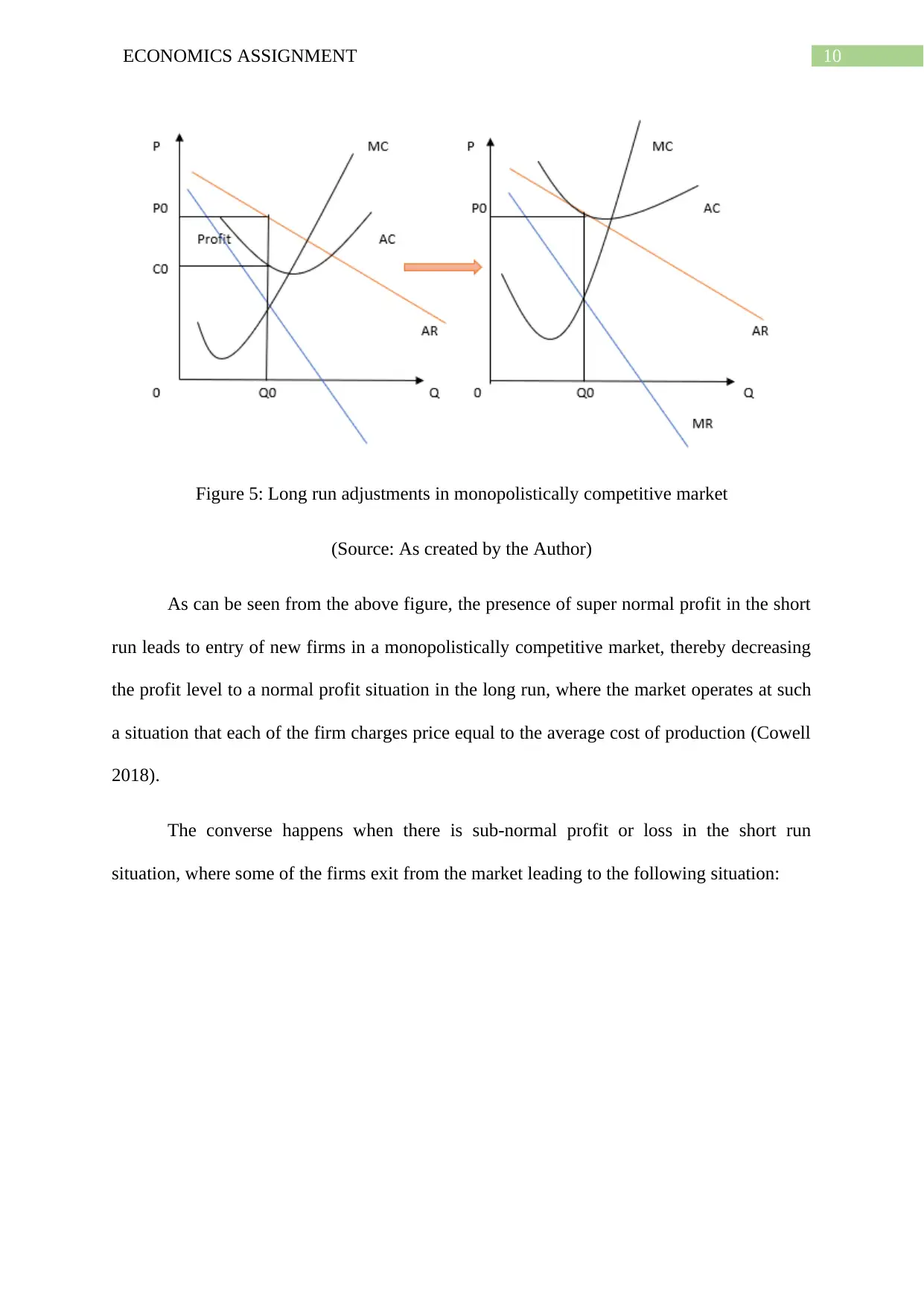
10ECONOMICS ASSIGNMENT
Figure 5: Long run adjustments in monopolistically competitive market
(Source: As created by the Author)
As can be seen from the above figure, the presence of super normal profit in the short
run leads to entry of new firms in a monopolistically competitive market, thereby decreasing
the profit level to a normal profit situation in the long run, where the market operates at such
a situation that each of the firm charges price equal to the average cost of production (Cowell
2018).
The converse happens when there is sub-normal profit or loss in the short run
situation, where some of the firms exit from the market leading to the following situation:
Figure 5: Long run adjustments in monopolistically competitive market
(Source: As created by the Author)
As can be seen from the above figure, the presence of super normal profit in the short
run leads to entry of new firms in a monopolistically competitive market, thereby decreasing
the profit level to a normal profit situation in the long run, where the market operates at such
a situation that each of the firm charges price equal to the average cost of production (Cowell
2018).
The converse happens when there is sub-normal profit or loss in the short run
situation, where some of the firms exit from the market leading to the following situation:
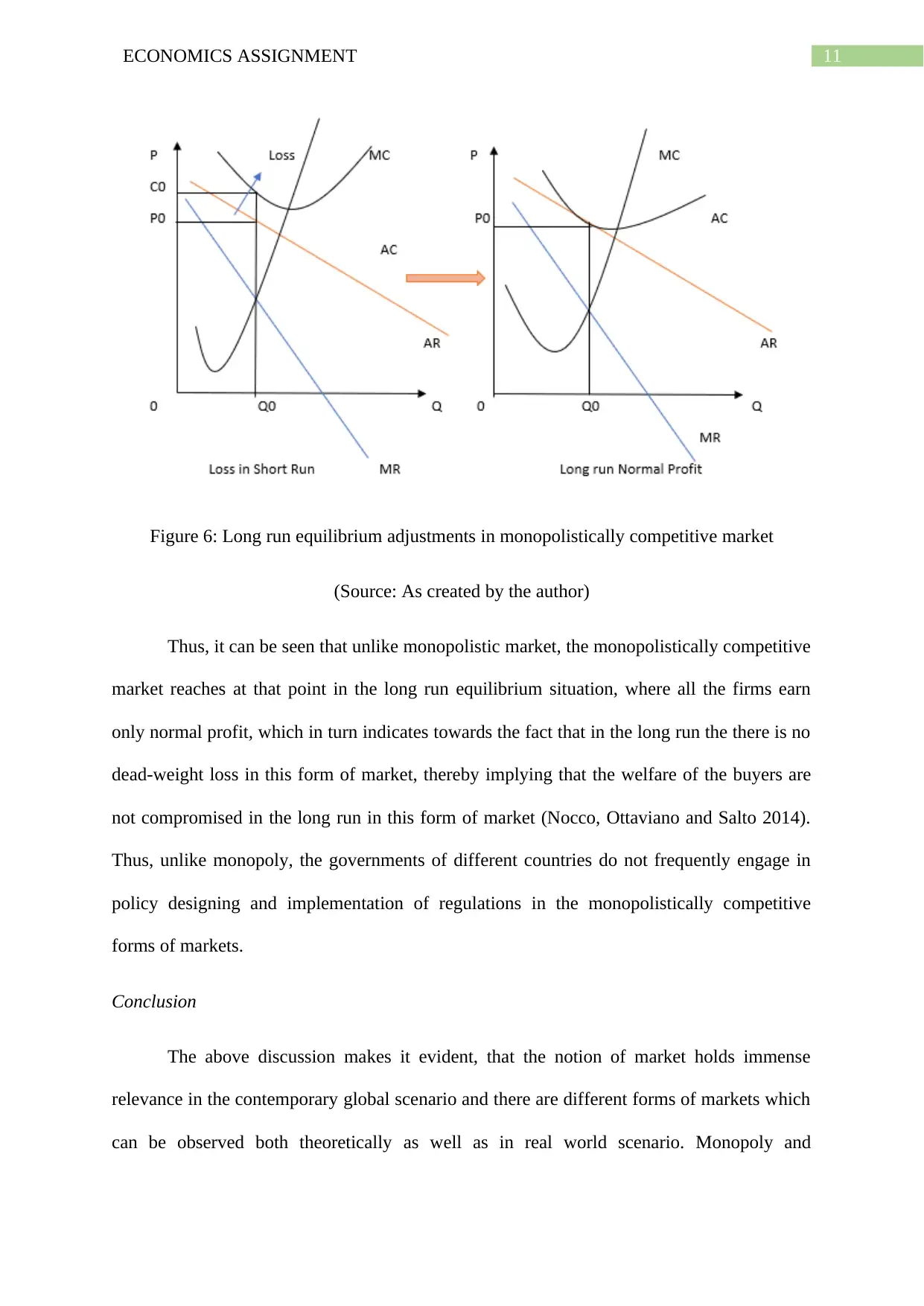
11ECONOMICS ASSIGNMENT
Figure 6: Long run equilibrium adjustments in monopolistically competitive market
(Source: As created by the author)
Thus, it can be seen that unlike monopolistic market, the monopolistically competitive
market reaches at that point in the long run equilibrium situation, where all the firms earn
only normal profit, which in turn indicates towards the fact that in the long run the there is no
dead-weight loss in this form of market, thereby implying that the welfare of the buyers are
not compromised in the long run in this form of market (Nocco, Ottaviano and Salto 2014).
Thus, unlike monopoly, the governments of different countries do not frequently engage in
policy designing and implementation of regulations in the monopolistically competitive
forms of markets.
Conclusion
The above discussion makes it evident, that the notion of market holds immense
relevance in the contemporary global scenario and there are different forms of markets which
can be observed both theoretically as well as in real world scenario. Monopoly and
Figure 6: Long run equilibrium adjustments in monopolistically competitive market
(Source: As created by the author)
Thus, it can be seen that unlike monopolistic market, the monopolistically competitive
market reaches at that point in the long run equilibrium situation, where all the firms earn
only normal profit, which in turn indicates towards the fact that in the long run the there is no
dead-weight loss in this form of market, thereby implying that the welfare of the buyers are
not compromised in the long run in this form of market (Nocco, Ottaviano and Salto 2014).
Thus, unlike monopoly, the governments of different countries do not frequently engage in
policy designing and implementation of regulations in the monopolistically competitive
forms of markets.
Conclusion
The above discussion makes it evident, that the notion of market holds immense
relevance in the contemporary global scenario and there are different forms of markets which
can be observed both theoretically as well as in real world scenario. Monopoly and
⊘ This is a preview!⊘
Do you want full access?
Subscribe today to unlock all pages.

Trusted by 1+ million students worldwide
1 out of 15
Related Documents
Your All-in-One AI-Powered Toolkit for Academic Success.
+13062052269
info@desklib.com
Available 24*7 on WhatsApp / Email
![[object Object]](/_next/static/media/star-bottom.7253800d.svg)
Unlock your academic potential
Copyright © 2020–2025 A2Z Services. All Rights Reserved. Developed and managed by ZUCOL.




